TRIM Performance:
While SSD's offer many benefits, there are some downsides to using flash memory. One of the biggest issues people run into is performance degradation. Over time, an SSD will run out of fresh blocks and will have to write over data the file system has marked as deleted. This procedure is very complicated and can slow an SSD's write speeds considerably.
To fix this problem, most manufacturers have added TRIM support to their SSDs. The TRIM command allows an operating system, such as Windows 7, to tell an SSD which data blocks are no longer in use. Using this information, the drive pro-actively erases these blocks and adds them to the free block pool.
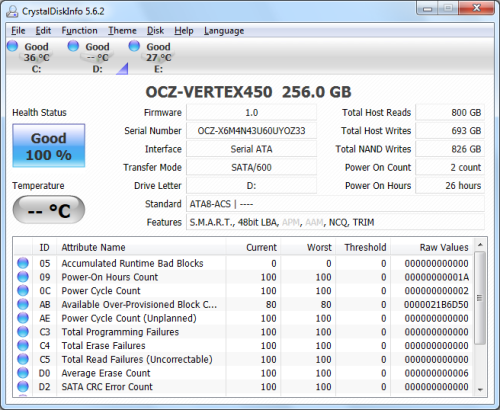
The Vertex 450 also uses a number of other flash management techniques including background garbage collection, dynamic and static wear-leveling and advanced flash defect management. Where flash defect management and wear leveling optimize the way data is written on the drive, garbage collection maintains "like new" performance by reorganizing data to maximize the number of free cells.
To test the Vertex 450's TRIM and garbage collection functions, I first put the drive in a "dirty" state. I used Iometer to fill the entire drive and then ran a random write test for 30 minutes. Looking at the screenshot below, you can see that the Vertex 450's average read and write speeds dropped to 287.2 MB/s and 70.5 MB/s, respectively.
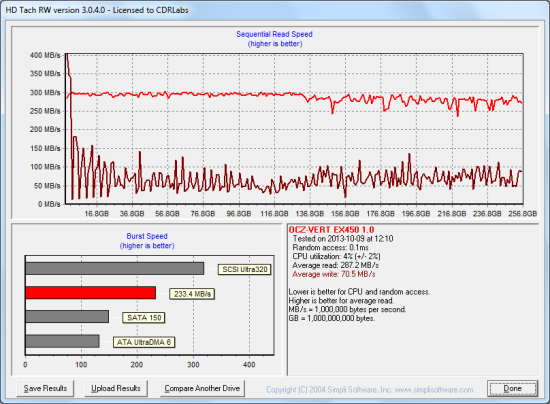
OCZ Vertex 450 - Dirty
The Vertex 450's average write speed bounced back up to 350.6 MB/s within a matter of minutes. However, its average read speed dropped down to 247.8 MB/s while it was recovering.
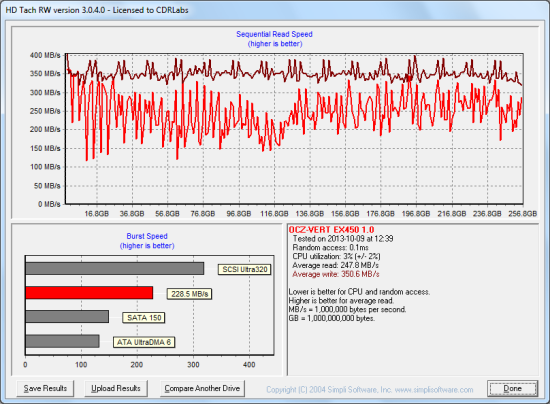
OCZ Vertex 450 - Recovering
I let the computer sit for about an hour and a half and then reran the test. Looking at the screenshot below, you can see that the Vertex 450's average read speed had increased to 343.3 MB/s.
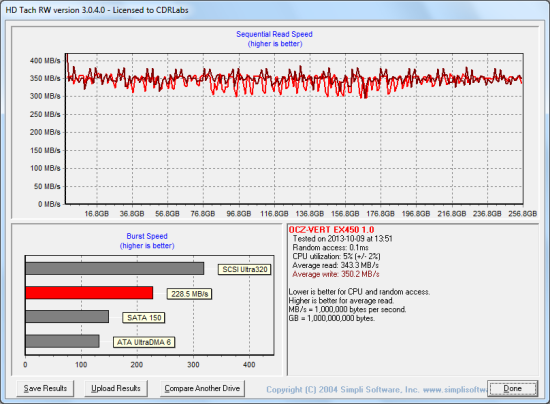
OCZ Vertex 450 - After TRIM
Lastly, I used OCZ's Toolbox utility to perform a secure erase on the Vertex 450. With the drive wiped clean, it had average read and write speeds of 385.0 MB/s and 406.9 MB/s, respectively.
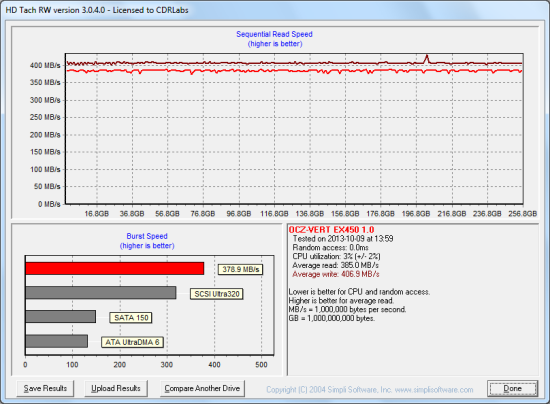
OCZ Vertex 450 - Secure Erased
Final Thoughts:
With the Vector taking the top spot as OCZ's flagship drive, the Vertex 450 has been repositioned as a more mainstream SSD. Designed for today’s multimedia, multitasking world, the Vertex 450 combines OCZ's new Indilinx-infused Barefoot 3 M10 controller with Micron's 20nm synchronous MLC NAND flash. With the M10 running at a lower clock speed than the original Barefoot 3, the Vertex 450 isn't quite as fast as the Vector. However, it still performed quite well in our sequential read and write tests, reading at speeds as high as 552 MB/s and writing at speeds in excess of 490 MB/s. The Vertex 450 also had no problems holding its own in our random write tests, producing more than 68,000 IOPS at low queue depths. Moreover, it performed equally well with compressible and incompressible data and was able to sustain these speeds, even after intensive use.
The only real issue I have with the Vertex 450 is its price. While intended as a more affordable alternative to the Vector, the retail prices of the two drives are very close. So close, in fact, that the Vector is actually cheaper at some retailers. Unless you need AES encryption, this makes it very hard to justify buying the Vertex 450 over the better performing Vector.
The Vertex 450 is available now in 128GB, 256GB and 512GB capacities. Prices on Amazon currently range from $119 up to $500, with the 256GB version reviewed here going for about $230.

Highs:
- Available in 128GB, 256GB and 512GB capacities
- Good sequential and random read and write performance
- Performs equally well with compressible and incompressible data
- SATA 6Gb/s interface
- Synchronous NAND flash
- Large DRAM cache
- Supports TRIM and idle background garbage collection
- AES 256-bit encryption
- Includes a 2.5" to 3.5" adapter bracket
- Includes Acronis True Image cloning software
- 3 year warranty
Lows:
- Pricey

